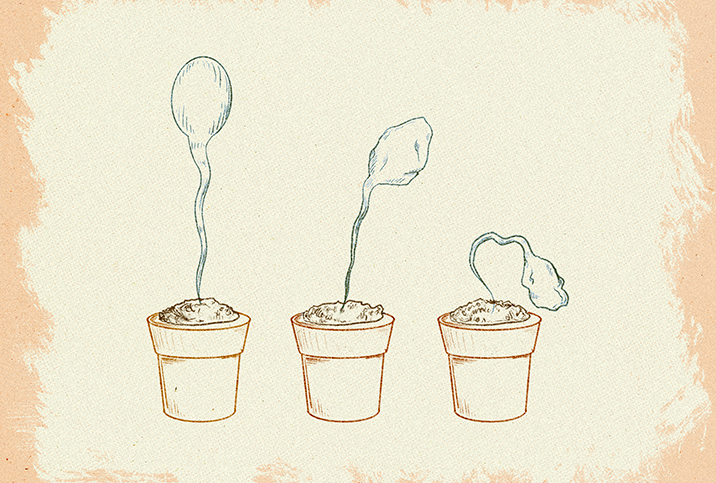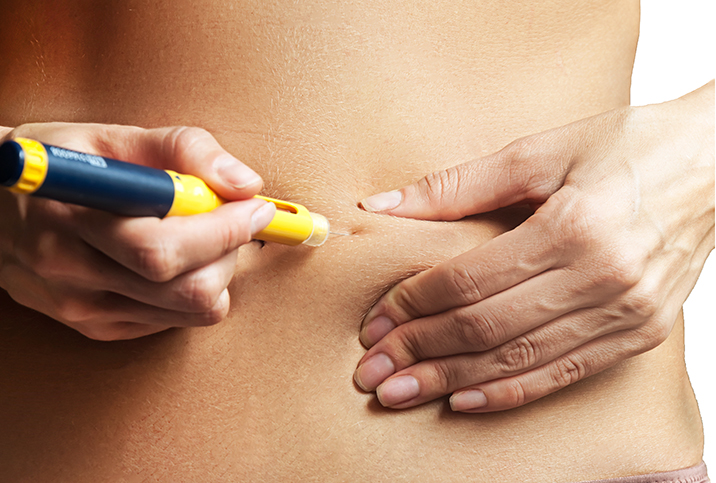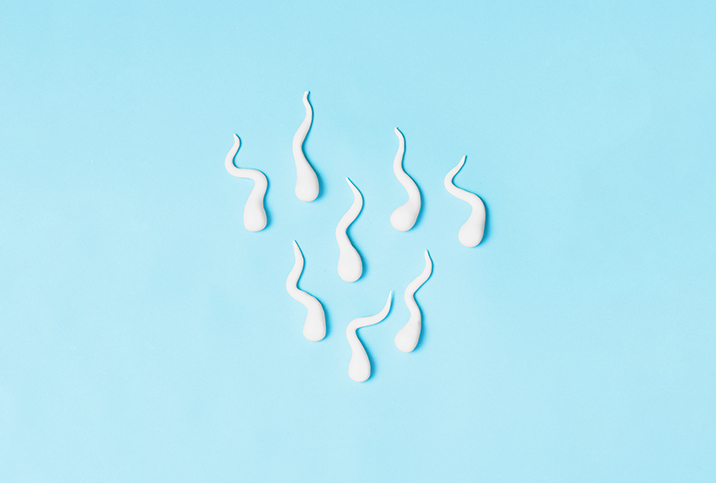Please Stop Believing These Female Fertility Inaccuracies

Trying to get pregnant is difficult enough without relying on inaccurate information. Whether it's due to the lack of sexual education in schools, the occasional hardheadedness of men, the inability of many women to explain fertility properly or whatever else, misconceptions about female fertility abound.
We talked to experts about the female fertility inaccuracies they hear regularly and what they want men to understand better about their female partners. One aspect they agree on is that most men—probably all people, to be honest—need a little more education regarding the intricacies of getting pregnant.
"Nearly all men have zero understanding of female anatomy," said Matthew Macer, M.D., a reproductive endocrinologist and infertility specialist at Halo Fertility in Los Angeles. "This holds true from the location of arousal centers, like the clitoris, up to the fact that the ovaries are not actually attached to the uterus and fallopian tubes. In order to better understand their female partner, most of them simply need a brief, 10-minute review of the anatomy and reproduction."
You can review the anatomy on your own time. For now, let's jump into five common inaccuracies surrounding women's fertility. Getting pregnant (or not getting pregnant) is easier when both partners have a good understanding of what's actually going on down there.
Inaccuracy #1
Fertility is a 'women's issue'
The most common inaccurate belief men have about female fertility is that all fertility problems stem from the woman.
"The most common misconception in the male's mind [is] that if there is a problem getting pregnant, it is likely because of a problem with their female partner," Macer said.
These men may be surprised to learn that infertility issues don't discriminate between sexes.
"Infertility affects 10 percent of reproductive-age couples, therefore, this common problem should not be talked about as a woman's issue," said Karenne Fru, M.D., a fertility specialist at Oma Fertility in Atlanta.
Macer chalks up this misconception to a lack of sexual education for many men.
"As arrogant as that may sound, it's not their fault," he explained. "Most men haven't been taught about reproduction since their fifth-grade 'sex education' class. They have just been focusing on not getting anyone pregnant."
The reality of the situation is that one-third of infertility cases are due to male fertility issues, said Sam Najmabadi, M.D., an OB-GYN, infertility specialist and a reproductive endocrinologist at the Center for Reproductive Health & Gynecology in Beverly Hills, California.
"A lot of times, people come in and say, 'Oh, yeah, I'm here to check my wife.' And I'm like, 'Yeah, I don't think so. I need to check you, too,'" he said.
And if it's not just a male fertility factor causing problems, that doesn't necessarily mean it's all female-based, either.
"The remaining causes are either female [or] combined male/female. Up to 15 percent of the time, no exact cause can be found, which is known as 'unexplained infertility,'" Macer said.
"Reproduction is an inefficient process," Fru added. "Once infertility is identified, it is imperative to individually assess both members of the reproductive dyad. This is the only way to efficiently address the deficiencies in an already inefficient process."
There is no need to assign "blame." To determine the source of a fertility problem, a lot of testing has to be done.
"We do an analysis of [sperm] volume count, concentration, motility and morphology. And if that is normal, we leave them alone. If it's abnormal, it means nothing. We repeat the test, because a repeated abnormal [result] means something," said Najmabadi, who is also affiliated with Cedars-Sinai Medical Center in Los Angeles. "And on this female side, we do all their hormone levels for ovarian reserve, check their uterus and fallopian tubes, and so on and so forth. So once that's all done, then we talk about options."
Options may include assisted reproductive technology (ART), such as in vitro fertilization, medications or surgery.
Inaccuracy #2
Day 14 of the menstrual cycle is magic
The best day to get a woman pregnant is the 14th day of her cycle, right? Well, not for everyone. The 28-day cycle is an average, meaning many women experience a longer or shorter duration.
"For most women, it takes about 13 to 14 days to grow and ovulate an egg, which would make the total length of the cycle 28 days," Macer explained. "This is why women are taught that they are most fertile around day 14 of their period. But it's important to remember that it's only in women with 28-day menstrual cycles."
When the duration of the menstrual cycle changes, so does the prime ovulation day.
"Most people have periods that are about 26 to 30 days," Najmabadi said. "So if it's 26 minus 14, it's 12, right? And if it is 30 minus 14, it's 16, you know, and so on and so forth. So people most often ovulate on day 12, 13, 14, 15, 16."
It's important for men to understand that their female partner's cycle can vary for many reasons. While some women experience a very regular cycle and can easily predict when they will ovulate, this isn't always the case.
"There are many reasons someone may not have a 28-day cycle. Some women grow eggs faster, especially as they get older, some women grow eggs slower, some women have ovulatory dysfunction, and others don't have a healthy luteal phase," Macer said.
Inaccuracy #3
Basal body temperature is the best way to know when the female is ovulating
A woman's body temperature changes throughout her menstrual cycle. The basal body temperature—or the lowest body temperature attained during rest—increases an average of half a degree Fahrenheit after ovulation. This means tracking temperature regularly for months can help establish a pattern to predict key ovulation days. It's not particularly helpful in the moment, however.
So what's the better alternative? According to Najmabadi, it's a urine test.
"Now you can check your urine and know when you're ovulating," he said. "You check your temperature, it tells you when you did ovulate, and it's too late."
Najmabadi added that relying on cervical mucus is similarly ineffective. A urine test is your best bet because it can identify the day—maybe even a day and half—before ovulation.
Macer advises couples with regular periods (24 to 35 days) to start using ovulation predictor kits—urine tests—once daily starting on day 10 of their period and up until day 21.
"If no ovulation is detected after two months of testing, they should see a specialist," Macer said.
Inaccuracy #4
Certain sex positions can increase the chances of getting pregnant
It's fun to think specific sex positions can increase a couple's chances of getting pregnant, but it doesn't usually make sense anatomically.
Once sperm has entered the cervix and uterus, it is in the fallopian tubes within seconds, according to studies, Najmabadi explained.
"If the sperm is in the back of the vagina and able to get into the cervix, then it's all you need," he said.
There is an argument for positions potentially having an impact in rare cases.
"There are patients who have, for example, endometriosis and their uterus is flipped backwards and the cervix is pointing up," Najmabadi said. "You could argue in those cases, depending on the angle of the cervix, which position of sex would be better. So that is, in certain cases, probably logical. But in the majority of patients, their uterus is smack in the middle and it makes no difference."
So for couples trying to get pregnant, switching positions can't hurt—and may be fun—but it's unlikely to make a difference in conception for most people.
Research has yielded no universal pregnancy-guaranteed position, but Fru emphasized that sex for pregnancy shouldn't become a burden.
"More important is that sex does not become a chore with a goal of achieving pregnancy," she said. "The timing of sex just before ovulation and during ovulation is most helpful in achieving pregnancy."
Inaccuracy #5
Women can't get pregnant after age 35
You may have heard of the "fertility cliff," the time in a woman's life when her fertility takes a steep drop. The phrase is buzzy and makes for good headlines, but it's just not true. In fact, the oldest mother to conceive naturally was 59 years old, according to Guinness World Records.
So why do we hear so much about age 35 being the fertility cliff? The answer is nuanced.
"At the age of 35, it starts to become harder for women to conceive because it's harder for their eggs to grow into healthy embryos that result in live births; embryos that have 46 chromosomes," Macer said.
If an embryo doesn't have 46 chromosomes, it can stop growing early, end in a miscarriage or result in a live birth but with chromosomal abnormalities, such as cases of Down syndrome.
"It's important to remember that the ovaries don't have a watch, so 35 is not an exact number," Macer emphasized.
According to Najmabadi, fertility actually starts declining around age 30. It's important to note, though, that declining fertility does not make pregnancy impossible. Fertility is less of a cliff and more of a slow descent.
"When you're 20 years old trying to have a baby—assuming your tubes are open, your uterus is normal, the partner's sperm is good and your hormone levels are good—you have about a 20 percent per month chance of getting pregnant," he said. "When you are 30 years old, it's a 10 percent per month chance. When you are 39, it's a 3 percent chance. And over the age of 40, it's less than 1 percent chance per month."
Don't trust the "wisdom" of the crowd when it comes to family planning and fertility. The five inaccuracies explained away here are just the beginning. Seeing a specialist is the best way to address any questions you have.
If you don't have a specialist and want help connecting with one, Giddy telehealth makes it easy, with access to hundreds of healthcare professionals. Video visits have become a viable option for most people, and more physicians, including fertility experts, have added them as a service. Many can even accommodate same-day appointments.

















